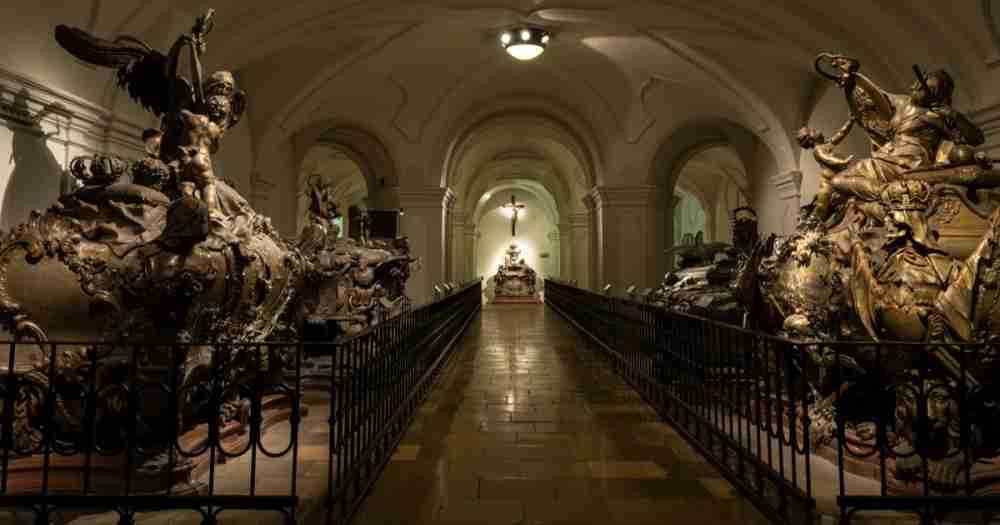The Imperial Crypt, also known as the Capuchin Crypt, is located in the basement of the Capuchin Church in the old town of Vienna.
It has been the burial place of the Habsburgs since 1617. The Habsburg family still uses them to this day.
Here you will find the most important information about the buried personalities, admission prices and the history.
What Can I See in the Imperial Crypt?

The mortal remains of 12 emperors and 19 empresses and queens from the House of Habsburg and their family members as well as one non-Habsburg woman rest in the Imperial Crypt. It is the final resting place of a total of 150 deceased, including Empress Elisabeth (Sisi), Emperor Franz Joseph, Empress Maria Theresa and Emperor Leopold.
You can view richly decorated and simple sarcophagi, heart runes and grave monuments of the Habsburgs in the extraordinary vault system of ten rooms.
The individual rooms can be divided into 9 different tombs and each reflect the epoch of their creation.
The Charles crypt and the magnificently decorated Maria Theresa crypt are particularly worth seeing. Both are characterized by a graceful rococo style.
On your stroll through 400 years of Austrian and European history, you can also learn more about the past of the famous House of Habsburg.

Famous Sarcophagi
- Empress Elisabeth "Sisi": The empress of hearts is located in the Franz Joseph's Crypt, right next to the sarcophagi of her husband and son Rudolf. Her coffin is always decorated with flowers.
- Emperor Franz Joseph I: The sarcophagus of Emperor Franz Joseph I in the Franz Joseph Crypt acts as a symbol of inviolability and human loneliness. It rests on a white marble base and towers above the sarcophagi of his wife Sisi and his son Rudolf. The sobriety of this tomb corresponds to secessionism, the artistic period of the time.
- Empress Maria Theresa: The double sarcophagus of Empress Maria Theresa, in which she rests together with her husband Emperor Franz I Stephan of Lorraine, is particularly magnificent. Numerous plastic figures adorn the coffin. On the sides there are reliefs depicting political and military events from the life of the imperial couple. The sarcophagus lies in the comparatively pompous Maria Theresa crypt, which was kept in the Rococo style.

Admission, Tickets & Prices
- Tickets: Admission for adults is €7.50. Young people under the age of 18 pay €4.50. Children under the age of 6 enjoy free entry. A detailed and up-to-date ticket overview can be found here.
- Annual Pass: An annual pass is available for €26.50. Young people pay €16 for the annual ticket.
- Guided Tours: Interested parties can take a guided tour to learn more about the Capuchin crypt and the history of the Habsburgs. The tours usually last one hour. All current tours can be found here.
Burial Rituals of the Habsburgs
Knocking Ceremony
A special burial ritual developed over time at Habsburg burials: the knocking ceremony. Even if no written Habsburg burial protocol documents the ritual, Empress Zita and her two sons were last buried according to this ceremonial in 1989.
When the funeral procession arrived in front of the Capuchin Church, the following knocking ceremony took place:
The master of ceremonies knocked three times on the gate of the Capuchin Church, whereupon the custodian of the imperial crypt answered: "Who wants admission?" The master of ceremonies then named the respective emperor, archduke or empress or archduchess of the Habsburg family. The response from within was, "We don't know him/her," after which the ritual was repeated two more times. The third time, however, when asked who would like to be admitted, the master of ceremonies answered only with the first name and the suffix "a mortal sinful man". Only then did the reply come: “Come in, he/she!”, with which the gate opened and the coffin was laid to rest in the imperial crypt.
The background to this ceremonial is the belief that man appears before God without a title, dignity, honors or awards, but only with his faith and the good deeds that result from it.
Separate Burial
Another Habsburg ritual is that the body, entrails and heart of the Habsburgs were buried separately.
From 1654 to 1878, the hearts of the Habsburgs were buried in silver containers in the heart crypt in the Augustinian church. The entrails were temporarily buried in the ducal crypt of St. Stephen's Cathedral.

History of the Capuchin Crypt
The construction of the Capuchin monastery and the associated crypt goes back to a decree by Empress Anna in 1617. The construction of the crypt was delayed due to the Thirty Years' War and could only be completed in 1633.
Empress Anna and her husband Mathias received the first tombs in the crypt in the same year.
In the course of the following decades and centuries, the crypt was expanded more and more. In total, it was expanded and modernized eight times. In 1909 the Imperial Crypt received electric light. Air conditioning has also been added.
Not all sarcophagi have survived over the years. Some of the buried had to be reburied.
Most recently, in 2011, Otto von Habsburg, son of the last Emperor Charles I, was buried in the Imperial Crypt. Today there is only room for one more grave in the crypt. The Habsburg family decides who will receive it.
Contact
- Address: Tegetthoffstrasse 2, 1010 Vienna
- U-Bahn: U1, U3 Stephansplatz, U1, U2, U4 Karlsplatz
- Opening Times: The current opening hours can be found on the Imperial Crypt website .

